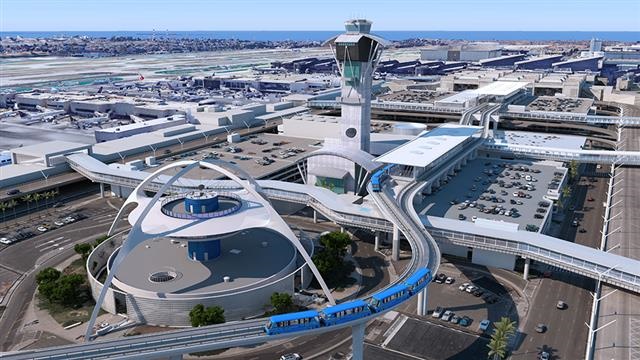
The Los Angeles City Council unanimously voted to approve a 30-year, $4.9 billion contract with LAX Integrated Express Solutions (LINXS) to design, build, finance, operate, and maintain the Automated People Mover (APM) train system at Los Angeles International Airport (LAX).
The APM is the centerpiece of the Landside Access Modernization Program (LAMP), which also includes a Consolidated Rent-a-Car (ConRAC) facility, Intermodal Transportation Facility-West, and associated roadway improvements. The APM will reduce vehicle congestion in the terminal loop, provide a connection with L.A. Metro's regional transportation system, create new and convenient locations for passenger pick-up and drop-off outside of the terminal loop, reduce emissions, and provide reliable access to the terminals.
The Los Angeles World Airports (LAWA) Board of Airport Commissioners (BOAC) approved the contract at its April 5 meeting. Prior to that, BOAC selected LINXS as the Recommended Developer at the February 15 meeting and entered into an Early Works Agreement, which allowed LINXS to begin pre-construction activities such as hiring, soil testing, engineering and furthering design of the APM.

LINXS has committed to partner with LAWA in developing opportunities for local small businesses, creation of good-paying career jobs, and fostering economic growth.
"The new Automated People Mover will transform the LAX experience for travelers by removing the frustration of the tangled traffic inside the horseshoe,” said Councilman Joe Buscaino, chair of the L.A. City Trade, Travel, and Tourism Committee (TTT). "Coupled with the new consolidated rent-a-car facility and the LAX/Crenshaw line, in a few short years going to LAX will become stressless for generations to come.”
Convenience, reliability, and easy accessibility are key elements of the user experience and are integral requirements for the APM. Trains will arrive every two minutes, have wide doors for easy access with luggage, large windows for viewing, plenty of hand holds, and seats for those in need. Station platforms are open air, light-filled and have escalators, elevators, and moving walkways for quick, convenient access to the terminals.
Architectural features include a viewing platform of the iconic Theme Building, an Experience L.A. center with an 800-square-foot LED programmable screen and an LED light band that accents the 2.25-mile guideway. LAWA anticipates that the APM will offer a maximum ridership capacity of 10,000 passengers per hour and up to 87.7 million passengers per year.
The system will be operational in 2023.
The APM will be built using a Public-Private Partnership (P3) contracting model. LINXS will be designing and constructing the system and will also be responsible for operating and maintaining the train and stations for a 30-year period. This incentivizes the construction and operating systems to be built to last.
Today’s approval marks the largest contract ever awarded in the City’s history. The item was heard at Los Angeles City Council’s TTT committee meeting on Tuesday, where it was also unanimously approved.
LINXS is comprised of Fluor, Balfour Beatty, ACS Infrastructure Development, Dragados USA, HOCHTIEF PPP Solutions, Flatiron, HDR, and HNTB. Bombardier Transportation will provide the APM Operating System, including all vehicles. LINXS' team members have extensive experience building and operating APMs domestically and internationally. LINXS' rail provider, Bombardier Transportation, has been involved in operating numerous APM systems in the U.S. as well as APM systems in Dubai, Heathrow and Munich.

0 Comments
See all comments